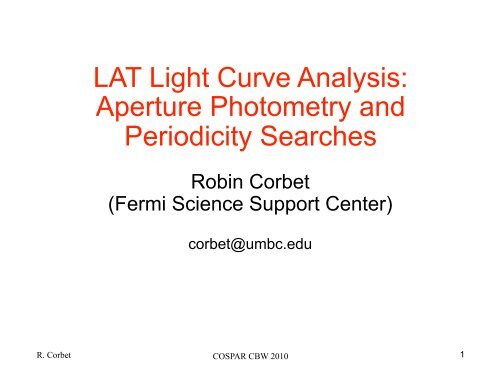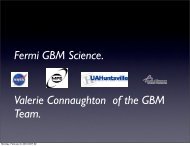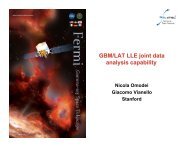LAT Light Curve Analysis: Aperture Photometry and ... - Fermi - NASA
LAT Light Curve Analysis: Aperture Photometry and ... - Fermi - NASA
LAT Light Curve Analysis: Aperture Photometry and ... - Fermi - NASA
You also want an ePaper? Increase the reach of your titles
YUMPU automatically turns print PDFs into web optimized ePapers that Google loves.
R. Corbet<br />
<strong>LAT</strong> <strong>Light</strong> <strong>Curve</strong> <strong>Analysis</strong>:<br />
<strong>Aperture</strong> <strong>Photometry</strong> <strong>and</strong><br />
Periodicity Searches<br />
Robin Corbet<br />
(<strong>Fermi</strong> Science Support Center)<br />
corbet@umbc.edu<br />
COSPAR CBW 2010<br />
1
<strong>Photometry</strong><br />
R. Corbet<br />
Two methods<br />
Talk Outline<br />
<strong>LAT</strong> specific considerations<br />
Recipe for <strong>LAT</strong> aperture photometry<br />
Error bars for low count rates<br />
Periodicity Searches<br />
Binary gamma-ray sources<br />
Searching for periods, power spectra<br />
Weighting power spectra, exposure weighting<br />
COSPAR CBW 2010<br />
2
R. Corbet<br />
What is <strong>Photometry</strong>?<br />
<strong>Photometry</strong> is the measurement of the flux from<br />
an astronomical source of photons.<br />
It can either be an absolute measurement of the<br />
flux (e.g. ergs cm -2 s -1 ) or a relative<br />
measurement (e.g. counts s -1 ).<br />
Relative measurements may be either relative<br />
to other objects, or to the same object at<br />
different times.<br />
A light curve is a series of photometric<br />
measurements as a function of time.<br />
COSPAR CBW 2010<br />
3
R. Corbet<br />
<strong>Aperture</strong> <strong>Photometry</strong><br />
The simplest form of photometry is aperture<br />
photometry.<br />
You just measure the flux collected inside a<br />
particular region of the sky.<br />
This is originally done with optical telescopes by<br />
using a physical aperture (e.g. a hole in a piece<br />
of metal).<br />
Now, with imaging instruments, it is possible to<br />
use a software defined aperture.<br />
COSPAR CBW 2010<br />
4
R. Corbet<br />
<strong>LAT</strong> <strong>Photometry</strong><br />
<strong>LAT</strong> light curves can be obtained in two basic<br />
ways:<br />
Likelihood analysis (B. Lott presentation)<br />
<strong>Aperture</strong> photometry<br />
Likelihood analysis has the potential for greater<br />
sensitivity <strong>and</strong> absolute flux measurements.<br />
<strong>Aperture</strong> photometry is easier, faster, <strong>and</strong> has<br />
the benefit of model independence.<br />
This presentation only deals with aperture<br />
photometry.<br />
COSPAR CBW 2010<br />
5
Things to be Aware of with <strong>Aperture</strong><br />
<strong>Photometry</strong><br />
The aperture contains photons from not just the<br />
source you’re interested in.<br />
R. Corbet<br />
It also contains photons from nearby sources <strong>and</strong><br />
the background. The background is particularly<br />
strong in the Galactic plane.<br />
The aperture can be made smaller to reduce<br />
the background. But this also reduces the<br />
number of photons from the source.<br />
The aperture can be made larger to increase<br />
the photons from the source. But this increases<br />
the background.<br />
COSPAR CBW 2010<br />
6
<strong>LAT</strong> <strong>Aperture</strong> Optimization<br />
In optical/X-ray, aperture photometry relatively straightforward.<br />
e.g. point spread function not energy dependent.<br />
Want to choose aperture to maximize signal to noise ratio:<br />
− S/N = S/(S + B) 1/2 (S = source photons, B = background)<br />
<strong>LAT</strong> aperture photometry complicated by:<br />
− PSF energy dependence<br />
− Background from other sources <strong>and</strong> Galactic plane is<br />
complex <strong>and</strong> energy dependent.<br />
Optimum aperture size <strong>and</strong> energy range to maximize S/N<br />
varies from source to source...<br />
R. Corbet COSPAR CBW 2010<br />
7
<strong>LAT</strong> S/N aperture dependence<br />
For two different sources the optimum signal-to-noise ratio is<br />
obtained for different radii.<br />
R. Corbet COSPAR CBW 2010<br />
8
Tools Used for <strong>Aperture</strong> <strong>Photometry</strong><br />
Data server<br />
fkeypar/pget<br />
gtselect<br />
gtmktime<br />
gtbin<br />
gtexposure<br />
fv or fdump + external data manipulation scripts<br />
R. Corbet<br />
COSPAR CBW 2010<br />
9
R. Corbet<br />
Steps<br />
It is recommended to use a script to chain<br />
together the tools.<br />
fkeypar – determine file start <strong>and</strong> stop times<br />
gtselect – filter data based on time, zenith limit,<br />
energy, position, <strong>and</strong> event class<br />
gtmktime – create good time intervals<br />
gtbin – make quasi-light curve (counts rather than<br />
rate)<br />
fdump – export data<br />
other tools – convert counts to rates, calculate<br />
errors<br />
COSPAR CBW 2010<br />
10
Get Photon File Start/Stop Times<br />
$ fkeypar "L090923112502E0D2F37E71_PH00.fits[1]" TSTART<br />
(photon start time = 266976000.)<br />
$ fkeypar "L090923112502E0D2F37E71_PH00.fits[1]" TSTOP<br />
(photon stop time = 275369897.)<br />
The values obtained with “fkeypar” will then be accessible using “pget”<br />
R. Corbet<br />
COSPAR CBW 2010<br />
11
R. Corbet<br />
Filter the Photon File<br />
$ gtselect zmax=105 emin=100 emax=200000 infile=“L090923112502E0D2F37E71_PH00.fits"<br />
outfile=temp2_1DAY_3C454.3.fits ra=343.490616 dec=16.148211 rad=1 tmin=26697<br />
6000. tmax=275369897. evclsmin=3 evclsmax=10<br />
Parameters specify:<br />
- Energy range (100 to 200,000 MeV)<br />
- Source coordinates<br />
- 1 degree radius aperture<br />
- start <strong>and</strong> stop times previously determined<br />
(N.B. If you're going to barycenter then the min <strong>and</strong> max times<br />
should instead be slightly greater/less than the times in the spacecraft<br />
file.)<br />
- evclsmin = 3 for DIFFUSE class (for simulated data use 0)<br />
Writes to file: temp2_1DAY_3C454.3<br />
COSPAR CBW 2010<br />
12
R. Corbet<br />
Calculate GTIs<br />
(Good Time Intervals)<br />
$ gtmktime scfile="L090923112502E0D2F37E71_SC00.fits" filter="(DATA_QUAL==1) &&<br />
(angsep(RA_ZENITH,DEC_ZENITH,343.490616,16.148211)+1
R. Corbet<br />
Extract a <strong>Light</strong> <strong>Curve</strong><br />
$ gtbin algorithm=LC evfile=temp3_1DAY_3C454.3.fits outfile=lc_1DAY_3C454.3.fits<br />
scfile=L090923112502E0D2F37E71_SC00.fits tbinalg=LIN tstart=266976000.<br />
tstop=275369897. dtime=86400<br />
Parameters specify:<br />
- Make a light curve (LC)<br />
- Input file is output file from gtselect<br />
- Spacecraft file<br />
- Linear time bins<br />
- Start <strong>and</strong> stop times again<br />
- dtime = 86400: 1 day bins<br />
Writes to file: lc_1DAY_3C454.3.fits<br />
COSPAR CBW 2010<br />
14
Calculate Exposures of Time Bins<br />
$ gtexposure infile="lc_1DAY_3C454.3.fits" scfile="L090923112502E0D2F37E71_SC00.fits"<br />
irfs="P6_V3_DIFFUSE" srcmdl="none" specin=-2.1<br />
Parameters specify:<br />
- Spacecraft file<br />
- Instrument response functions (“irfs”). If, for example, SOURCE<br />
class rather than DIFFUSE was used in gtselect then use<br />
irfs="P6_V3_SOURCE”<br />
- srcmdl – enables a more complex model than the default simple<br />
power law to be used in the exposure calculation.<br />
- specin – photon spectral index for power-law spectrum. Note<br />
that the minus sign must be used.<br />
An EXPOSURE column is added to the input file: lc_1DAY_3C454.3.fits<br />
R. Corbet<br />
COSPAR CBW 2010<br />
15
R. Corbet<br />
The Output File<br />
The “final” file will contain Time (in MET), Bin<br />
width (s) number of counts in the bin, Error<br />
Exposure.<br />
To convert to rates use e.g. fv or other software<br />
to divide counts by exposure. (Also convert<br />
from MET to MJD.)<br />
Error bars in output file are sqrt(counts)<br />
For (e.g.) few counts this may be incorrect.<br />
To do things correctly is more complicated (see<br />
supplemental material).<br />
COSPAR CBW 2010<br />
16
R. Corbet COSPAR CBW 2010<br />
17
HEASARC HOME OBSERVATORIES ARCHIVE CALIBRATION SOFTWARE TOOLS STUDENTS / TEACHERS / PUBLIC<br />
GENERAL TOOLS MULTI-MISSION TOOLS MISSION TOOLS<br />
xTime - A Date/Time Conversion Utility<br />
Calendar Time Formats Input Time [UTC] Output Time<br />
ISO 8601 date (yyyy-MM-dd hh:mm:ss)<br />
Calendar date (yyyyMondd at hh:mm:ss)<br />
Year <strong>and</strong> day number (yyyy:ddd:hh:mm:ss)<br />
Julian Day (ddddddd.ddd...)<br />
Modified Julian Day (ddddd.ddd...)<br />
Mission-Specific Time Formats Input Time [MET] Output Time [MET]<br />
RXTE seconds since 1994.0 UTC (decimal)<br />
RXTE seconds since 1994.0 UTC (hexadecimal)<br />
RXTE mission day number (dddd:hh:mm:ss)<br />
RXTE decimal mission day (dddd.ddd...)<br />
Swift seconds since 2001.0 UTC (decimal)<br />
Swift mission day number (dddd:hh:mm:ss)<br />
<strong>Fermi</strong> seconds since 2001.0 UTC (decimal)<br />
<strong>Fermi</strong> mission week (integer)<br />
R. Corbet Swift decimal mission day (dddd.ddd...) COSPAR CBW 2010<br />
18<br />
Suzaku seconds since 2000.0 UTC (decimal)<br />
http://heasarc.gsfc.nasa.gov/cgi-bin/Tools/xTime/xTime.pl
R. Corbet<br />
barycentering<br />
barycentering - correction of times to center of<br />
mass of the solar system<br />
gtbary can also be used to barycenter light<br />
curves.<br />
gtbary must be done as the last step.<br />
If you barycenter the photon file the exposure time<br />
calculations will be wrong!<br />
Spacecraft file must cover longer (not same)<br />
time range than photon file.<br />
If needed, use gtselect to trim down time range<br />
by tiny amount (e.g. 60 seconds)<br />
COSPAR CBW 2010<br />
19
More Advanced Error Bar Treatment<br />
Dealing with error bars for small numbers of<br />
counts has been discussed in the astronomical<br />
literature by e.g.<br />
R. Corbet<br />
Gehrels, 1986, ApJ, 303, 336<br />
Kraft, Burrows, & Nousek, 1991, ApJ, 374, 344<br />
Useful review of concept of “coverage” by<br />
Heinrich in:<br />
www-cdf.fnal.gov/publications/cdf6438_coverage.pdf<br />
COSPAR CBW 2010<br />
20
R. Corbet<br />
Crude Approach to Low-Count<br />
Errors<br />
Instead of taking errors as N 1/2 , where N is the<br />
observed number of counts, look at the ends of<br />
the error bars.<br />
i.e. what underlying “population” count rate would<br />
be consistent with the “sample” count rate?<br />
σ = ±0.5 + sqrt(N + 0.25)<br />
e.g. 0 → 0, +1, -0<br />
1 → 1, +1.62, -0.62<br />
2 → 2, +2, -1<br />
If needed, these errors can be “symmetrized”.<br />
COSPAR CBW 2010<br />
21
R. Corbet<br />
Binary Gamma-Ray Sources<br />
• Some types <strong>Fermi</strong>- <strong>LAT</strong> of binary star <strong>Fermi</strong> systems Symposium Washington are DC Nov expected<br />
4, 2009<br />
to be gamma-ray sources.<br />
R.Dubois 2/15<br />
COSPAR CBW 2010<br />
22
Looking for Binary Orbital Periods<br />
• Detection of a (non-pulse) period in an<br />
unidentified γ-ray source would be a strong<br />
indicator that the source is a binary.<br />
• Modulation of the γ-ray light curve would give<br />
key information on the γ-ray production<br />
mechanism.<br />
• Periods are expected to be mainly between<br />
~hours to ~years long.<br />
• A powerful way to search for a period in a light<br />
curve is to calculate the power spectrum…<br />
R. Corbet<br />
COSPAR CBW 2010<br />
23
A power spectrum is obtained by calculating the<br />
Fourier transform of a time series (e.g. a light<br />
curve), <strong>and</strong> then summing the sine <strong>and</strong> cosine<br />
amplitudes at each frequency.<br />
R. Corbet<br />
Power Spectra<br />
A periodic signal will give a peak in the power<br />
spectrum.<br />
COSPAR CBW 2010<br />
24
Power Spectrum of a Note Played<br />
R. Corbet<br />
Power<br />
Frequency<br />
on a Flute<br />
COSPAR CBW 2010<br />
(Figure from Tasha Vanesian)<br />
25
R. Corbet<br />
…<strong>and</strong> its Power Spectrum<br />
60 day precession<br />
period<br />
COSPAR CBW 2010<br />
3.9 day orbital period<br />
Harmonic of<br />
orbital period<br />
27
R. Corbet<br />
Calculating Power Spectra<br />
• A variety of software is available to calculate<br />
power spectra.<br />
• e.g. “powspec” in HEASARC Xronos package.<br />
• If data are evenly spaced, then it is possible to<br />
calculate a Fast Fourier Transform (FFT) which<br />
uses less computer time.<br />
• For unevenly spaced data, a power spectrum<br />
based on the Fourier Transform can still be<br />
calculated.<br />
• An important refinement of this is the Lomb-Scargle<br />
periodogram which has better statistical properties<br />
(Scargle 1982, ApJ, 263, 835).<br />
COSPAR CBW 2010<br />
28
Other Period Search Techniques<br />
• Although the power spectrum is very powerful,<br />
there are other ways to look for periodicities in<br />
the power spectrum.<br />
• The power spectrum is well-suited for the<br />
detection of sinusoidal modulation. Other<br />
techniques may work better if the modulation<br />
consists of, e.g., brief flares.<br />
• Many other techniques are related to “folding”<br />
data. i.e. taking a trial period <strong>and</strong> replacing data<br />
times with phase values for that period.<br />
R. Corbet<br />
COSPAR CBW 2010<br />
29
• What should be done if data points have<br />
different errors?<br />
•Scargle (1989) proposed that the effect of<br />
unequally weighted data points can be found by<br />
considering two points that coincide, <strong>and</strong><br />
treating them as a single point of double weight.<br />
• A “natural” approach to combining data points of<br />
different error bar size is to use the same<br />
weights as when calculating a weighted mean.<br />
R. Corbet<br />
Beyond the Basics:<br />
Weighted Power Spectra<br />
COSPAR CBW 2010<br />
30
• Based on the weighted mean, calculate the<br />
power spectrum of (yi - ymean)/σi 2<br />
• y i is the measured flux at time t i <strong>and</strong> σ i<br />
R. Corbet<br />
The Weighted Power Spectrum<br />
The weighted mean of a series of values: y1, y2, ... yn,<br />
is defined as:<br />
COSPAR CBW 2010<br />
is its error.<br />
31
Weighting Can Reveal Orbital<br />
Periods in Faint Sources (X-ray example)<br />
R. Corbet<br />
COSPAR CBW 2010<br />
32
Should <strong>LAT</strong> data be weighted?<br />
<strong>Fermi</strong> operates almost exclusively in sky<br />
survey mode:<br />
− For half day time bins <strong>and</strong> longer (<strong>and</strong><br />
also time bins that are multiples of the<br />
survey period) there is little variation in<br />
exposure.<br />
− Weighting not needed.<br />
− But, if time resolutions less than survey<br />
period are required then there are huge<br />
variations in exposure.<br />
− Appropriate weighting expected to be<br />
crucial.<br />
R. Corbet COSPAR CBW 2010<br />
33
How should <strong>LAT</strong> data be<br />
weighted?<br />
Weighting RXTE ASM <strong>and</strong> oher light<br />
curves by their errors works very well?<br />
Can/should <strong>LAT</strong> data be weighted by their<br />
errors?<br />
− <strong>LAT</strong> rates are counts/exposure.<br />
− Errors are ~(counts) 1/2 /exposure.<br />
− But, there are very few counts in each<br />
time bin. There are therefore shot-noise<br />
variations in count rate & error.<br />
− Alternative is to use Exposure<br />
weighting.<br />
R. Corbet COSPAR CBW 2010<br />
34
R. Corbet<br />
Exposure-Based Errors<br />
Calculate mean count rate.<br />
For each time bin, calculate the predicted<br />
number of counts for the exposure of that time<br />
bin.<br />
Take the square root of predicted number of<br />
counts.<br />
Divide by exposure to get rate error.<br />
This gives an error based only on the “quality”<br />
of each time bin.<br />
COSPAR CBW 2010<br />
35
Exposure Weighted Rates vs.<br />
Unweighted Raw Counts<br />
Exposure weighting of rates:<br />
Divide counts in bin by exposure time to get<br />
rates.<br />
Use a weight based on time - the weight is<br />
essentially multiplying by exposure time.<br />
i.e. both divide <strong>and</strong> multiply by exposure.<br />
Do effects of exposure just cancel out?<br />
No! - Crucial difference is subtraction of<br />
mean before calculating power spectrum.<br />
R. Corbet COSPAR CBW 2010<br />
36
Comparing weighting methods:<br />
1ks<br />
“Counts”<br />
1ks<br />
Exposure weighted<br />
1ks<br />
Error weighted<br />
1ks time bins.<br />
No weighting<br />
1 day time bins.<br />
No weighting.<br />
Red line = known binary period. Blue arrow = <strong>Fermi</strong> orbital period.<br />
R. Corbet COSPAR CBW 2010<br />
37
Results of Looking for Binary Orbital<br />
Periods in <strong>LAT</strong> <strong>Light</strong> <strong>Curve</strong>s...<br />
... will be reported on Monday!<br />
R. Corbet<br />
COSPAR CBW 2010<br />
38






